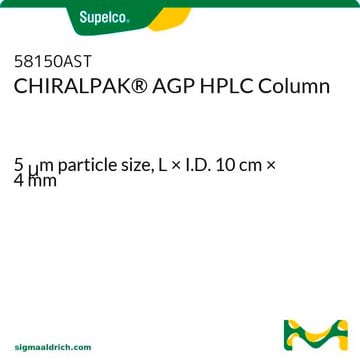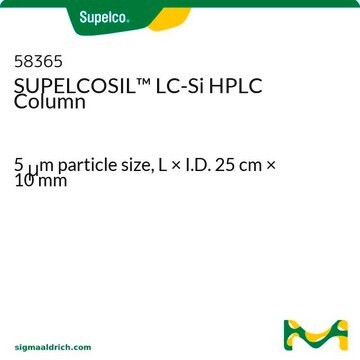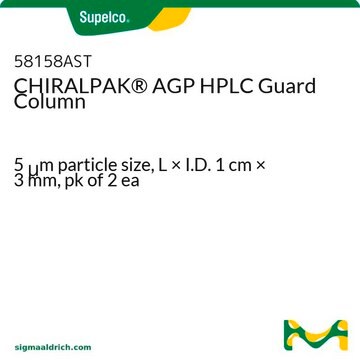Products may be shipped at a different temperature than the recommended long-term storage temperature. If the product quality is sensitive to short-term exposure to conditions other than the recommended long-term storage, it will be shipped on wet or dry-ice. If the product quality is NOT affected by short-term exposure to conditions other than the recommended long-term storage, it will be shipped at ambient temperature. As shipping routes are configured for minimum transit times, shipping at ambient temperature helps control shipping costs for our customers. For more information, please refer to the Storage and Transport Conditions document: https://www.sigmaaldrich.com/deepweb/assets/sigmaaldrich/marketing/global/documents/316/622/storage-transport-conditions-mk.pdf
58151AST
CHIRALPAK® AGP (5 μm) HPLC Columns
L × I.D. 15 cm × 4 mm, HPLC Column
Wybierz wielkość
23 270,00 zł
Wybierz wielkość
About This Item
23 270,00 zł
Polecane produkty
Nazwa produktu
CHIRALPAK® AGP HPLC Column, 5 μm particle size, L × I.D. 15 cm × 4 mm
Materiały
stainless steel column
Poziom jakości
agency
suitable for USP L41
linia produktu
CHIRALPAK®
opakowanie
pkg of 1 ea
producent / nazwa handlowa
CHIRALPAK®
Parametry
137 bar pressure (2000 psi)
20-30 °C temperature
40 °C max. temp.
metody
HPLC: suitable
dł. × śr. wewn.
15 cm × 4 mm
Matryca
fully porous particle
grupa aktywna macierzy
glycoprotein, alpha1- phase
wielkość cząstki
5 μm
pH robocze
2-8
metoda separacji
chiral
temp. przechowywania
2-8°C
Szukasz podobnych produktów? Odwiedź Przewodnik dotyczący porównywania produktów
Powiązane kategorie
Opis ogólny
Features:
- Direct reversed phase resolution of chiral molecules
- Stable with a variety of organic modifiers
- Available in analytical and semi-preparative sizes
(1) Hermansson, J. Direct liquid chromatographic resolution of racemic drugs using a1-acid glycoprotein as the chiral stationary phase. J. Chromatogr. A, 1983, 269, 71-80.
Zastosowanie
- Ocena enancjomerów R- (-) i S- (+) klenbuterolu podczas cyklu do pingowegolub ciągłego spożywania skażonego mięsa przy użyciu chiralnej chromatografii cieczowej LC-TQ-MS: Badanie to demonstruje zastosowanie chiralnej kolumny HPLC do rozdzielania enancjomerów klenbuterolu w próbkach biologicznych, zapewniając wgląd w wykrywanie substancji dopingujących lub narażenia na skażone mięso (Dolores et al., 2019).
- Charakterystyka stereochemiczna fluorowanych kwasów 2-(fenantren-1-ylo)propionowych za pomocą enancjoselektywnej analizy wysokosprawnej chromatografii cieczowej i elektronicznej detekcji dichroizmu kołowego: Badania te podkreślają zdolność chiralnych kolumn HPLC do rozróżniania enancjomerów złożonych związków fluorowanych, oferując metodę szczegółowej analizy o kluczowym znaczeniu w badaniach farmaceutycznych (Bertucci et al., 2012).
Informacje prawne
Wybierz jedną z najnowszych wersji:
Certyfikaty analizy (CoA)
It looks like we've run into a problem, but you can still download Certificates of Analysis from our Dokumenty section.
Proszę o kontakt, jeśli potrzebna jest pomoc Obsługa Klienta
Masz już ten produkt?
Dokumenty związane z niedawno zakupionymi produktami zostały zamieszczone w Bibliotece dokumentów.
Klienci oglądali również te produkty
-
How is shipping temperature determined? And how is it related to the product storage temperature?
1 answer-
Helpful?
-
-
How can I determine the shelf life / expiration / retest date of this product?
1 answer-
If this product has an expiration or retest date, it will be shown on the Certificate of Analysis (COA, CofA). If there is no retest or expiration date listed on the product's COA, we do not have suitable stability data to determine a shelf life. For these products, the only date on the COA will be the release date; a retest, expiration, or use-by-date will not be displayed.
For all products, we recommend handling per defined conditions as printed in our product literature and website product descriptions. We recommend that products should be routinely inspected by customers to ensure they perform as expected.
For products without retest or expiration dates, our standard warranty of 1 year from the date of shipment is applicable.
For more information, please refer to the Product Dating Information document: https://www.sigmaaldrich.com/deepweb/assets/sigmaaldrich/marketing/global/documents/449/386/product-dating-information-mk.pdfHelpful?
-
Active Filters
Nasz zespół naukowców ma doświadczenie we wszystkich obszarach badań, w tym w naukach przyrodniczych, materiałoznawstwie, syntezie chemicznej, chromatografii, analityce i wielu innych dziedzinach.
Skontaktuj się z zespołem ds. pomocy technicznej







